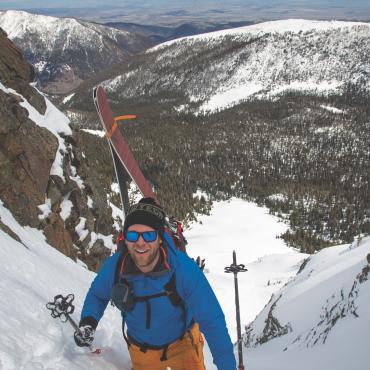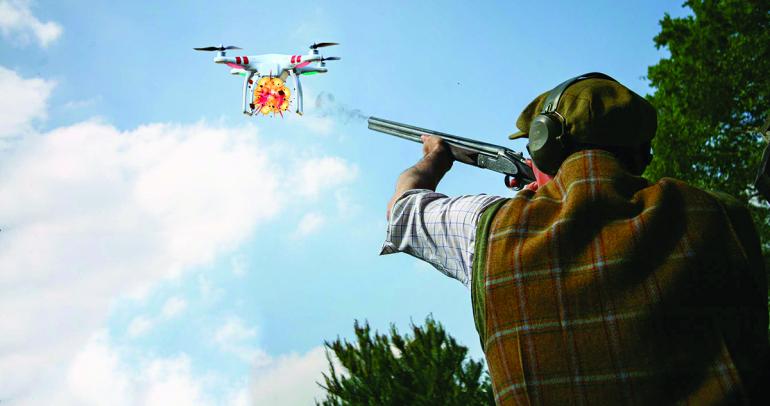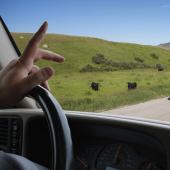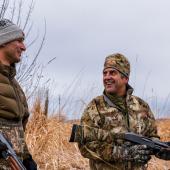Aerial Assault
Drones in the outdoors.
On a warm summer morning, a mile up Bear Trap Canyon in the Lee Metcalf Wilderness, there’s usually little to hear but the constant harmonics of the Madison River moving swiftly past, the whine of insects, and a cacophony of birds announcing the day. That’s the point of Wilderness, after all—there’s nothing to see or hear except Montana, unimproved, unimpeded, and unimpaired.
I was stooped low, investigating an eddy, in hopes of finding a fat rainbow, when it started. At first, I thought maybe I’d stepped on a hornet’s nest. The buzzing grew loud and agitated, cutting through the wilderness white noise. I dashed up the bank to escape. But there were no hornets. In fact, I couldn’t determine where the sound came from, until I looked skyward. There, hovering above the river a hundred feet away, was a drone.
The operator was nowhere to be seen, navigating illegally in the Wilderness by virtue of the video camera mounted on the drone’s undercarriage—which was pointed directly at me, recording my confusion. My bewilderment turned to rage, for in an instant, this technology and its operator had robbed me of my peace, my privacy, my Wilderness, and potentially even my safety. I leapt onto a streamside boulder and let fly with two outstretched birds of my own, shouting obscenities at the hovering craft. Perhaps it was coincidence, or perhaps the remote operator noticed my vehement objections, but the drone immediately flew back downstream and out of view, though its angry buzzing lingered. If I’d had a shotgun handy, I’d have taken that damned thing down—and I believe any self-respecting Montana judge would find such a shooting justified. Drones are a growing scourge in wild places.
Americans bought more than 1.3 million drones last year. And while recreational and commercial users are technically required to register with the FAA for $5, there is zero oversight, zero practical regulation, nor any licensing, permitting, or insurance required to own or operate drones up to 55 pounds—and that is a huge piece of flying equipment. Moreover, most of these aircraft are mounted with powerful, gimbal-stabilized HD video cameras. They are, in fact, spycraft.
In professional hands, drones produce beautiful aerial video footage. That’s undeniable. But they are a scourge all the same. My experience in the Lee Metcalf is unfortunately unremarkable, and drones pose problems for safety, security, and civil liberty wherever they fly. An illegal drone famously crashed into Grand Prismatic hot spring in a crowded part of Yellowstone National Park’s famous geyser basin in 2014—just one of many illegal drone activities reported in our National Parks every year.
According to the Federal Aviation Authority, dangerous and illegal drone incursions disrupted at least 25 active wildland fire operations in 2017, resulting in aerial firefighting efforts being halted, and contributing to loss of property and possibly life. This includes a drone that temporarily shut down firefighting efforts on the destructive Rice Ridge Fire in Seeley Lake last summer.
Drones are also used illegally (and unethically) to scout hunting areas and haze wildlife. In February 2017, a drone operator faced federal charges after stampeding 1,500 winter-stressed elk in Wyoming’s National Elk Refuge. Not to mention reports of invasion of privacy, stalking, and reckless endangerment attributed to drones every year.
No one visits Montana’s rivers, mountains, or woods to be hazed by buzzing aircraft, or filmed without consent. As a Montanan with libertarian leanings, I can’t reconcile any argument for recreational drones. They’re simply too invasive. The rights of someone piloting a hobbyist spycraft does not supersede the rest of society’s rights for safety or privacy, Wilderness experiences, ethical hunting practices, or (above all!) our right to recreate on public land unsurveilled. If you operate a drone, please think about how your toy will affect the rest of us. And if you choose to operate illegally, unethically, or in a manner unbecoming, well… there are an awful lot of shotguns in Montana.
Editor's note: This article was written in 2018.














